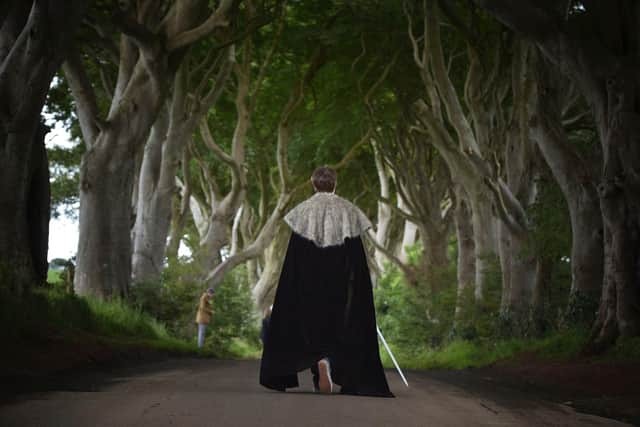Scotland's real-life Game of Thrones: King Alexander II was a 'psychopathic maniac' but probably needed to be – Susan Morrison
In 1222, King Alexander II was having a bit of bother in Caithness. His bishop, Adam, was annoying his flock. As a royally appointed man of the church, he had the right to impose taxes, or tithes, on the farmers of the diocese, and it usually took the form of food rather than money, sensibly enough. It's a good system to keep your clergy fed, but it would seem that Bishop Adam was a man fond of the little luxuries of life, such as butter.
In 1219, the dairy producers of Caithness were sending a span of butter from every 20 milked cows to the bishop's table. That's the measurement between the tip of the thumb to the tip of the pinkie. Yes, you could probably cheat by having a dairymaid with small fingers. In 1222, however, the bishop demanded butter from one in every ten cows. Even by today's standards, you can see that's a bit of a hike.
Advertisement
Hide AdAdvertisement
Hide AdThe congregation was annoyed enough to seek out their ‘jarl’, essentially their lord. His name was Jon Haraldsson, and it's worth noting those Norse names and terms. Caithness then was part of the Jarldom of Orkney. The account of what happened to the dairy-loving Bishop is even related in an Old Norse short poem, a pættir, called “Brenna Adams byskups”. Spoiler alert, the translation is “The Burning of Bishop Adam”.
‘Devil take the bishop’
Perhaps the jarl was having a bad day, or perhaps he just didn’t like Bishop Adam, but when the men of Caithness complained of the butter bill, he gave them short shrift and snorted: “The devil take the bishop and his butter; you may roast him if you please!” People in power should really think before speaking.
The bishop's flock met at Halkirk, and things seem to have gone out of hand fast. Men in the crowd started shouting “Roast him!” A lynch mob was forming. Bishop Adam was alerted to the danger. So, for that matter, was Jarl Jon Haraldson, but strangely he doesn't seem to have scrambled to the aid of the beleaguered churchman. The mob reached the very doors of the bishop's residence.
A monk was either sent to reason with the peasant army, or was standing by Bishop Adam's side. Tempers grew short, a blow came down. The monk fell back, his face smashed open. The mob lunged on the bishop, forcing him to retreat through his house, until he was trapped in a small kitchen at the back. The enraged taxpayers of Caithness set fire to the manor, and did indeed roast the bishop.


The shock waves hit the church and crown. The Melrose Chronicle, written by monks in Adam’s previous posting of Melrose Abbey, didn’t mince its words, writing up the bishop as a “partaker of the martyrdom of the saints” and sticking up for the right to “claim of tithes according to the use of ecclesiastical authority”.
King’s justice
Alexander II, who King John of England called the “red fox-cub”, was not someone to let this sort of behaviour slide. Bishop Adam had been his man, under the protection of his crown and sword, even if Caithness was nominally under the rule of another nation.
He took an entire army north. The peasant farmers of Caithness never stood a chance. Jarl Jon, the man who should have protected them, was called into the kingly presence and told in no uncertain terms to take a hike. A pilgrimage was probably a good idea. A long one.
And then he turned his attention to the bishop-roasters. Chronicle accounts say that he “killed the perpetrators, castrated their sons, and threw out their wives”. The Icelandic Annals noted that “the king of the Scots caused 80 men who had been present at the burning to have their hands and feet cut off; and many of them died.” You do have to wonder how some of them survived.
Advertisement
Hide AdAdvertisement
Hide AdThe wails of the mutilated probably wouldn’t have bothered Alexander II. Before this man’s father was even buried, he’d had himself crowned at Scone, armoured up and was sitting at the head of his first army, at an age when modern teens aren’t even allowed to legally drink. He was 16.
He suppressed his first revolt just a month into his reign, and set the pattern for his rule. He tolerated no opposition. When a rival dynasty rose in the north to threaten his throne he met the challenge with utter ruthlessness, including the execution of a baby girl. Even the most hardened chroniclers were left reeling by that.
Perhaps we shouldn’t judge him by the standards of our time. Dr Richard Oram of Stirling University, biographer of Alexander II, described him as a “psychopathic maniac”, and he likes him. But when he died, he left mainland Scotland unified, including even unruly, bishop-burning Caithness.
He had to be ruthless. The Scottish throne was a precarious place. Few of its occupants sat comfortably. When your enemies came after you, it was kill or be killed, and that usually included entire families. Even the legendary Robert Bruce fought rivals for the throne, and there were devastating consequences for the losers. When was the last time you met someone with the surname ‘Balliol’ or ‘Comyn’?
If you’d like to know more about not just Alexander, but Scotland’s pre-Stuart kings and their rivals for the crown of Scotland, there’s a new six-part podcast from BBC Scotland, called “House of the Lion – A Blood Soaked Throne”. It’s presented by myself and poet Len Pennie, in the company of some of Scotland’s greatest historians. Just be warned. It's gory. It makes certain massive television franchises look like a mild-mannered cookery show, even before they roast the bishop.
Comments
Want to join the conversation? Please or to comment on this article.
